Denoising of LCR Wave Signal of Residual Stress for Rail Surface Based on Lifting Scheme Wavelet Packet Transform
Abstract
:1. Introduction
2. Basic Theory
2.1. Lifting Scheme Wavelet Analysis
- split
- Predict
- Update
- Undo update
- Undo predict
- Merge
2.2. Lifting Scheme Wavelet Packet Analysis
- Same as LSWT, the original signal is split into even sample sets and odd sample sets , as shown in Equation (1).Through the following formulas, the signals of each frequency band decomposed in the first layer of the boosted wavelet packet are calculated:
- Calculate the signals of each frequency band decomposed in the L-th level of the LSWP through the following equations:
- When the signals in Equation (7) are reconstructed by LSWPT, the corresponding frequency band signal will be retained, and the rest will be set to zero. The signals are reconstructed according to the following equations:
2.3. Denoising Based on LSWPT
- Lifting wavelet packet decomposition.
- Determination of the optimal lifting wavelet packet base.
- Threshold quantization of LSWP decomposition coefficients.
- Signal LSWP reconstruction.
3. Experiment on the Measurement of Rail Surface Residual Stress
3.1. Method Principle of Measurement for Residual Stress Using Ultrasound
3.2. LCR Wave Signal Acquisition
4. Results and Discussion
4.1. LCR Wave Signal Preprocessing
4.2. Selection of the Optimal Wavelet Base and Decomposition Level of LCR Wave Signal
4.3. Performance Verification of LSWPT for LCR Wave
4.4. Ultrasonic Equipment Calibration and Residual Stress Measurement
5. Conclusions
- The wavelet families of Daubechies, Symlets, Coiflets, and Biorthogonal are suitable for ultrasonic LCR wave signal analysis. The wavelet base sym8 is tight support in the time domain and has a fast attenuation in the frequency domain. It can be used as the best wavelet base. The best decomposition level is 8.
- The four denoising methods based on wavelet analysis effectively removed most of the noise in LCR wave signals, and the SNRs were significantly improved. The calculation time of LSWT and LSWPT is shorter than that of traditional WT and WPT respectively.
- The WPT and LSPT methods are more effective advanced than WT and LSWT methods against the interference of high-frequency noise.
- The LSWPT denoising method can effectively improve the accuracy of residual stress on-line measurement.
Author Contributions
Funding
Institutional Review Board Statement
Informed Consent Statement
Data Availability Statement
Conflicts of Interest
References
- Shayegan, G.; Mahmoudi, H.; Ghelichi, R.; Villafuerte, J.; Wang, J.; Guagliano, M.; Jahed, H. Residual stress induced by cold spray coating of magnesium AZ31B extrusion. Mater. Des. 2014, 60, 72–84. [Google Scholar] [CrossRef]
- Xu, C.; Song, W.; Pan, Q.; Li, H.; Liu, S. Nondestructive Testing Residual Stress Using Ultrasonic Critical Refracted Longitudinal Wave. Phys. Procedia 2015, 70, 594–598. [Google Scholar] [CrossRef] [Green Version]
- Yan, H. Research on Nonlinear Ultrasonic Properties of Tension Stress in Metal Materials. Chin. J. Mech. Eng. 2016, 52, 22–29. [Google Scholar] [CrossRef]
- Pan, Q.; Liu, S.; Li, X.; Xu, C. Characteristic Evaluation on Bolt Stress by Ultrasonic Nondestructive Methods. Adv. Mater. Sci. Eng. 2015, 2015, 1–6. [Google Scholar] [CrossRef] [Green Version]
- Thakur, R.C.; Topno, R.; Krishna, B.; Roy, B.; Murty, G. Residual Stress Measurement in Rails. In Proceedings of the National Seminar on Non-Destructive Evaluation, Hyderabad, India, 7–9 December 2006; pp. 159–162. [Google Scholar]
- Silk, M.G. Relationships between metallurgical texture and ultrasonic propagation. Met. Sci. 1981, 15, 559–565. [Google Scholar] [CrossRef]
- Crecraft, D. The measurement of applied and residual stresses in metals using ultrasonic waves. J. Sound Vib. 1967, 5, 173–192. [Google Scholar] [CrossRef]
- Ouahabi, A. A review of wavelet denoising in medical imaging. In Proceedings of the 8th International Workshop on Systems, Signal Processing and Their Applications (IEEE/WoSSPA), Algiers, Algeria, 12–15 May 2013; pp. 19–26. [Google Scholar] [CrossRef]
- Ashikuzzaman; Rivaz, H. Denoising RF Data via Robust Principal Component Analysis: Results in Ultrasound Elastography. In Proceedings of the 2020 42nd Annual International Conference of the IEEE Engineering in Medicine & Biology Society (EMBC), Montreal, QC, Canada, 20 July, 2020; Institute of Electrical and Electronics Engineers (IEEE): Piscataway, NJ, USA, 2020; Volume 2020, pp. 2067–2070. [Google Scholar]
- Mao, Y.; Que, P. Noise suppression and flaw detection of ultrasonic signals via empirical mode decomposition. Russ. J. Nondestruct. Test. 2007, 43, 196–203. [Google Scholar] [CrossRef]
- Rai, H.M.; Chatterjee, K. Hybrid adaptive algorithm based on wavelet transform and independent component analysis for denoising of MRI images. Meas. 2019, 144, 72–82. [Google Scholar] [CrossRef]
- Singh, K.; Sharma, B.; Singh, J.; Srivastava, G.; Sharma, S.; Aggarwal, A.; Cheng, X. Local Statistics-based Speckle Reducing Bilateral Filter for Medical Ultrasound Images. Mob. Networks Appl. 2020, 25, 2367–2389. [Google Scholar] [CrossRef]
- Shao, D.; Yuan, Y.; Xiang, Y.; Yu, Z.; Liu, P.; Liu, D.C. Artifacts detection-based adaptive filtering to noise reduction of strain imaging. Ultrason 2019, 98, 99–107. [Google Scholar] [CrossRef]
- He, Q. Vibration signal classification by wavelet packet energy flow manifold learning. J. Sound Vib. 2013, 332, 1881–1894. [Google Scholar] [CrossRef]
- Mohammed, M.S.; Ki-Seong, K. Shift-invariant wavelet packet for signal de-noising in ultrasonic testing. Insight-Non-Destructive Test. Cond. Monit. 2012, 54, 366–370. [Google Scholar] [CrossRef]
- Luo, X. Wavelet Packet Analysis to Signal in Ultrasonic Testing. Chin. J. Mech. Eng. 2006, 42, 142–146. [Google Scholar] [CrossRef]
- Matz, V.; Smid, R.; Starman, S.; Kreidl, M. Signal-to-noise ratio enhancement based on wavelet filtering in ultrasonic testing. Ultrason. 2009, 49, 752–759. [Google Scholar] [CrossRef] [PubMed]
- Yan, X.L.; Dong, S.Y.; Wang, W.L.; Xu, B.S. Denoising and Defect Diagnosis of Material Ultrasonic Detection signal Based on Best Wavelet Packet Base. Appl. Mech. Mater. 2012, 239–240, 52–56. [Google Scholar] [CrossRef]
- Lang, X.; Hu, Z.; Li, P.; Li, Y.; Cao, J.; Ren, H. Pipeline Leak Aperture Recognition Based on Wavelet Packet Analysis and a Deep Belief Network with ICR. Wirel. Commun. Mob. Comput. 2018, 2018, 1–8. [Google Scholar] [CrossRef] [Green Version]
- Muthumari, S.; Singh, A.; Sharma, A.P. De-noising ultrasonic TOFD signals: A comparative study of wavelet packet method using sure with SSP technique. J. Theor. Appl. Inf. Technol. 2012, 37, 112–115. [Google Scholar]
- Hu, L.; Fang, Z.; Qin, L.; Mao, K.; Chen, W.; Fu, X. Modelling of received ultrasonic signals based on variable frequency analysis. Flow Meas. Instrum. 2019, 65, 141–149. [Google Scholar] [CrossRef]
- Peilu, L.; Chunguang, X.; Xianzan, W.; Hanming, Z. Thick Wall Pipe Ultrasonic Signals Processing Based on Wavelet Packet and Singular Value Decomposition, In Proceedings of the Seventh Asia International Symposium on Mechatronics. Lecture Notes in Electrical Engineering (LNEE 589), Hangzhou, China, 19 September 2020; Springer: Singapore, 2020; pp. 873–882. [Google Scholar]
- Zheng, R.-D.; Gao, Y.-Q.; Li, J.-L.; Gao, X.-R. A Locating Algorithm of Train Wheel Flaws in Ultrasonic Images Based on Cross-Correlation and Wavelet Packet Denoising. In Proceedings of the 2019 Far East NDT New Technology & Application Forum (FENDT), Qingdao, China, 24 June 2019; Institute of Electrical and Electronics Engineers (IEEE): Piscataway, NJ, USA, 2019; pp. 163–167. [Google Scholar]
- Daubechies, I.; Sweldens, W. Factoring wavelet transforms into lifting steps. J. Fourier Anal. Appl. 1998, 4, 247–269. [Google Scholar] [CrossRef]
- Donoho, D.L.; Johnstone, I.M. Adapting to unknown smoothness via wavelet shrinkage. J. Am. Stat. Assoc. 1995, 90, 1200–1224. [Google Scholar] [CrossRef]
- Yan, H.; Xu, C.; Xiao, D.; Cai, H. Properties of GH4169 Superalloy Characterized by Nonlinear Ultrasonic Waves. Adv. Mater. Sci. Eng. 2015, 2015, 1–8. [Google Scholar] [CrossRef] [Green Version]
- Tsui, P.P.; Basir, O.A. Wavelet basis selection and feature extraction for shift invariant ultrasound foreign body classification. Ultrason 2006, 45, 1–14. [Google Scholar] [CrossRef] [PubMed]
- Zhaoheng, D.; Shanghe, L.; Lei, W. Selection of the optimal wavelet bases for wavelet de-noising of partial discharge signal. In Proceedings of the 2010 2nd International Conference on Signal Processing Systems; Institute of Electrical and Electronics Engineers (IEEE): Piscataway, NJ, USA, 2010; Volume 3, pp. V3–400. [Google Scholar]
- Feng, X.; Neilan, M. Vanishing Moment Method and Moment Solutions for Fully Nonlinear Second Order Partial Differential Equations. J. Sci. Comput. 2008, 38, 74–98. [Google Scholar] [CrossRef]
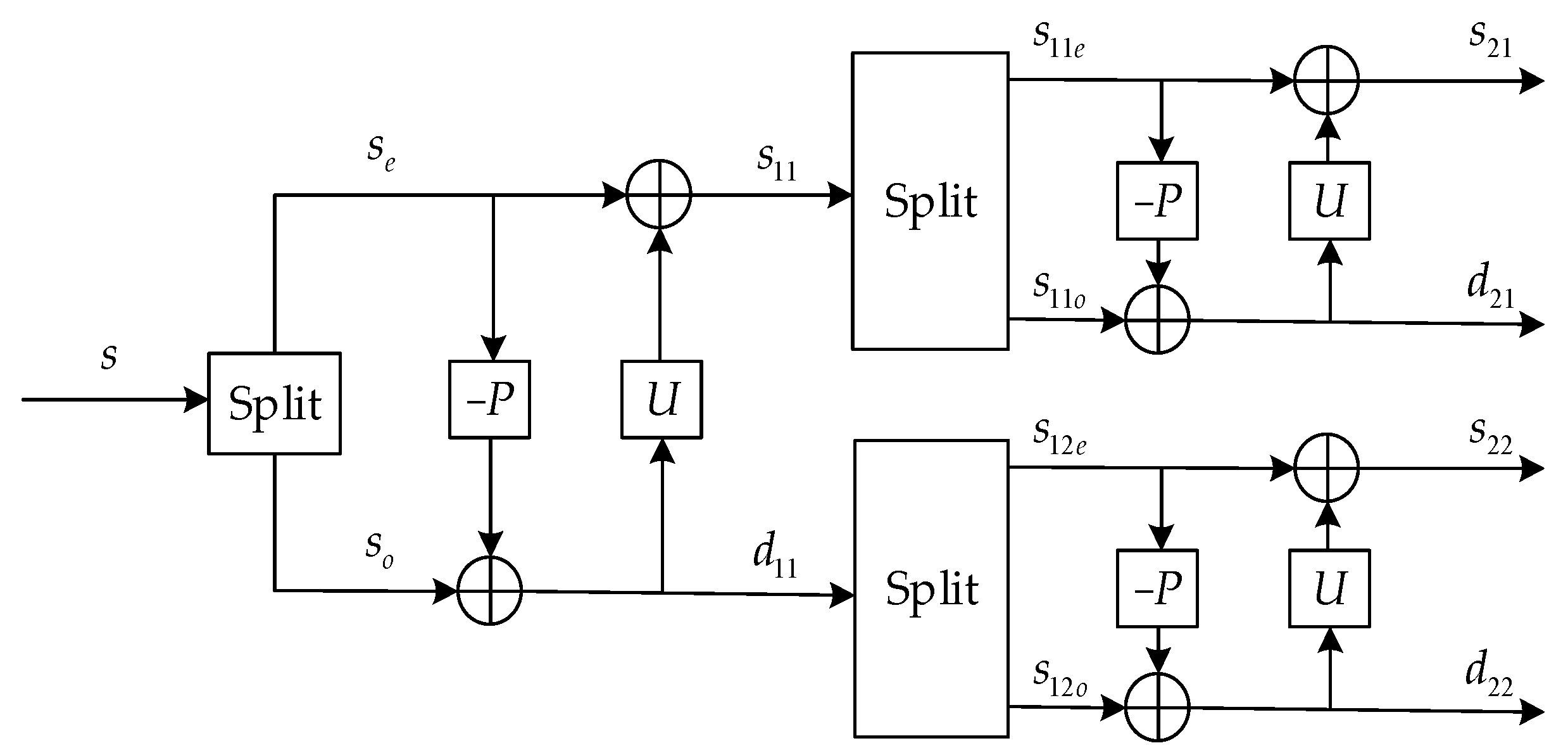

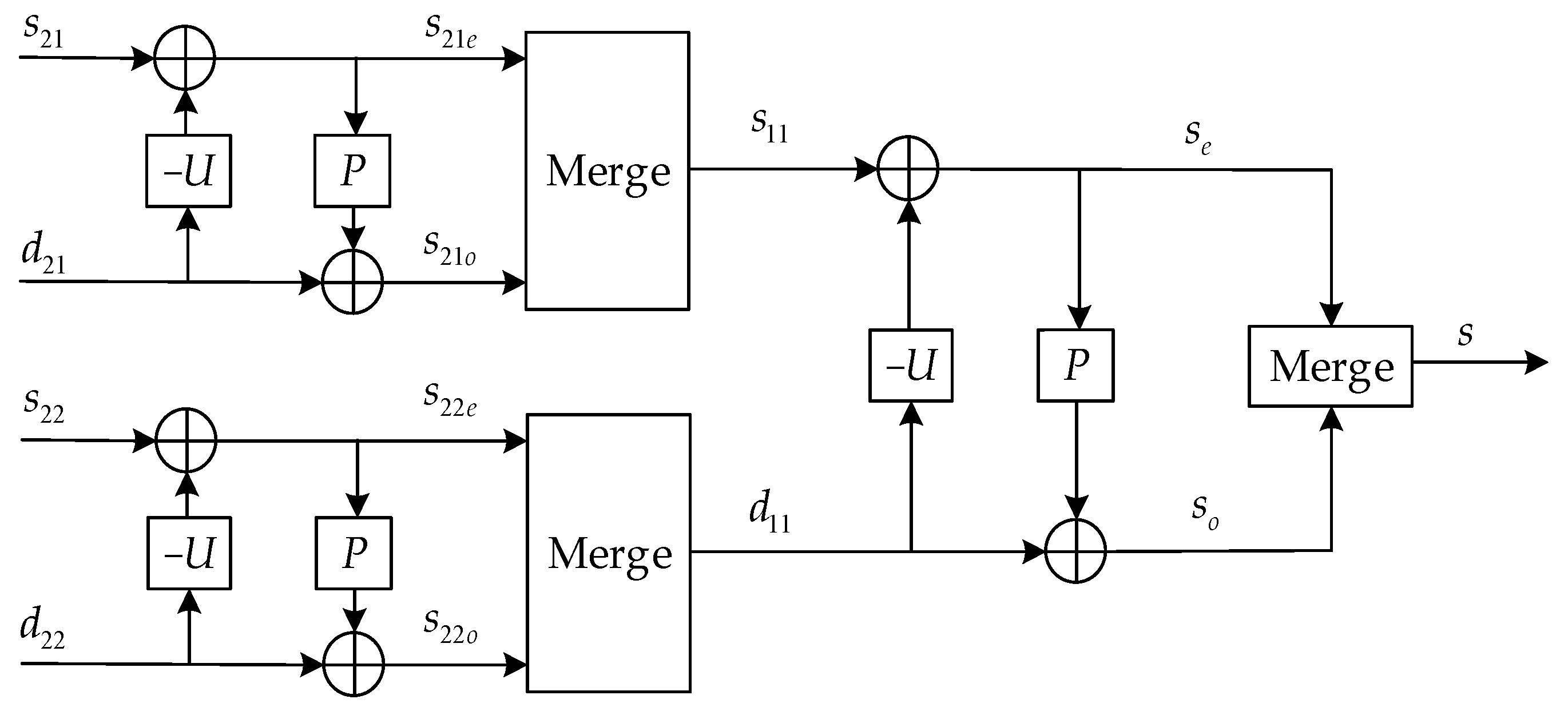

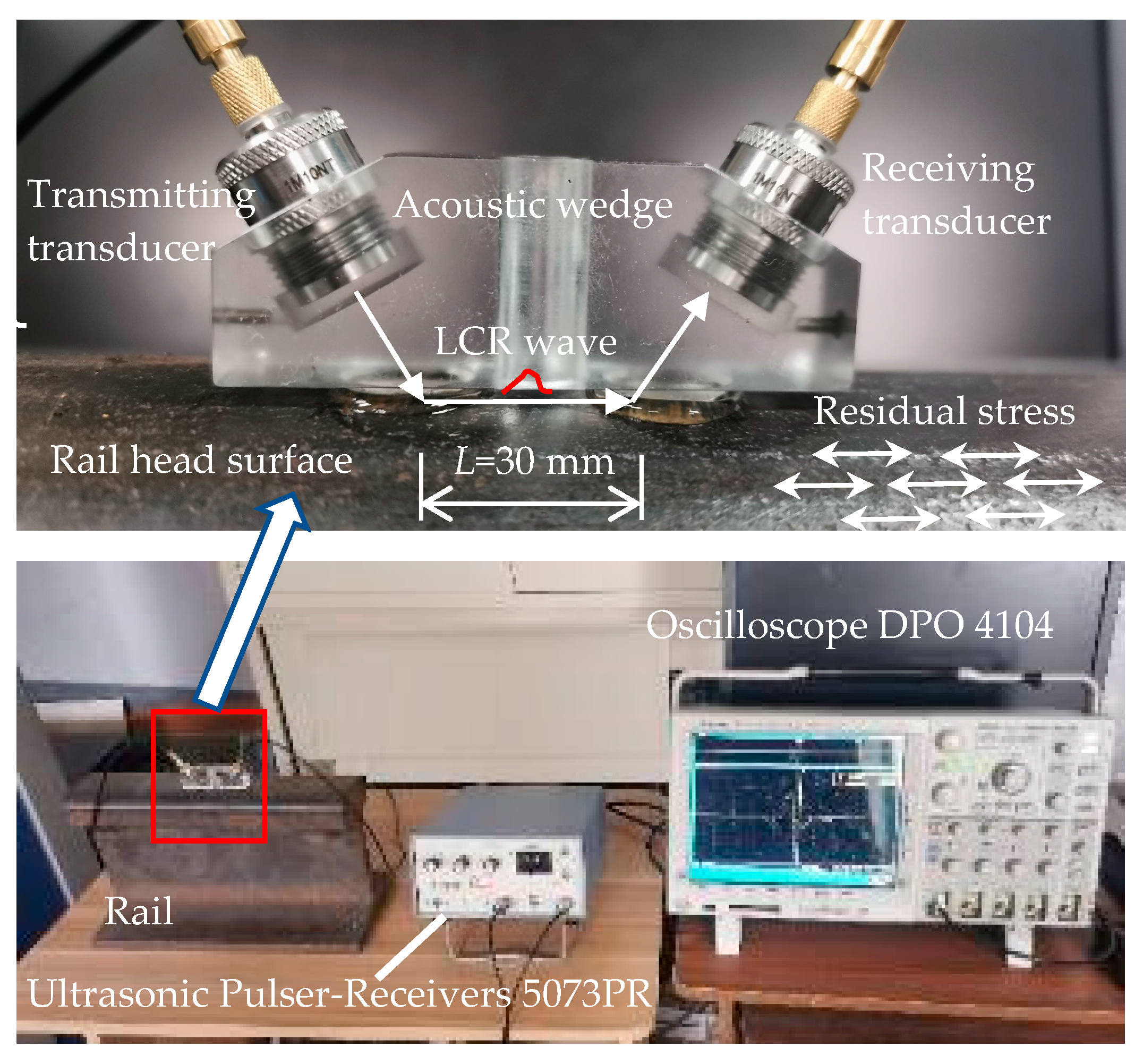
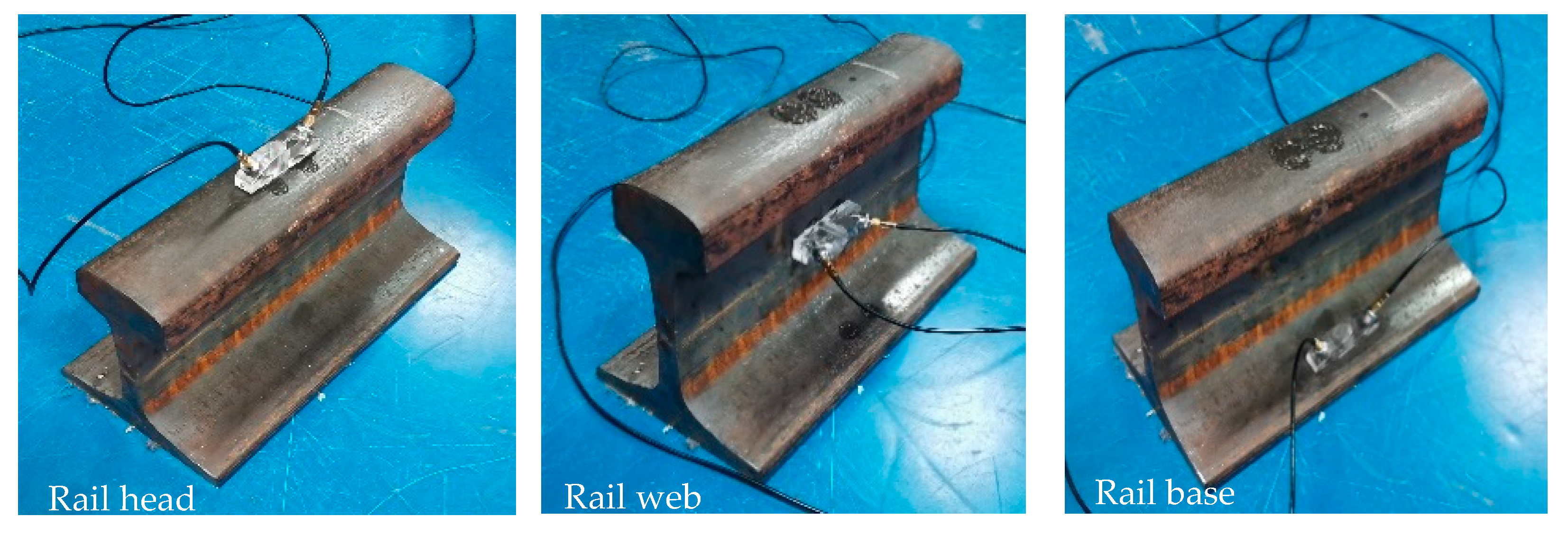

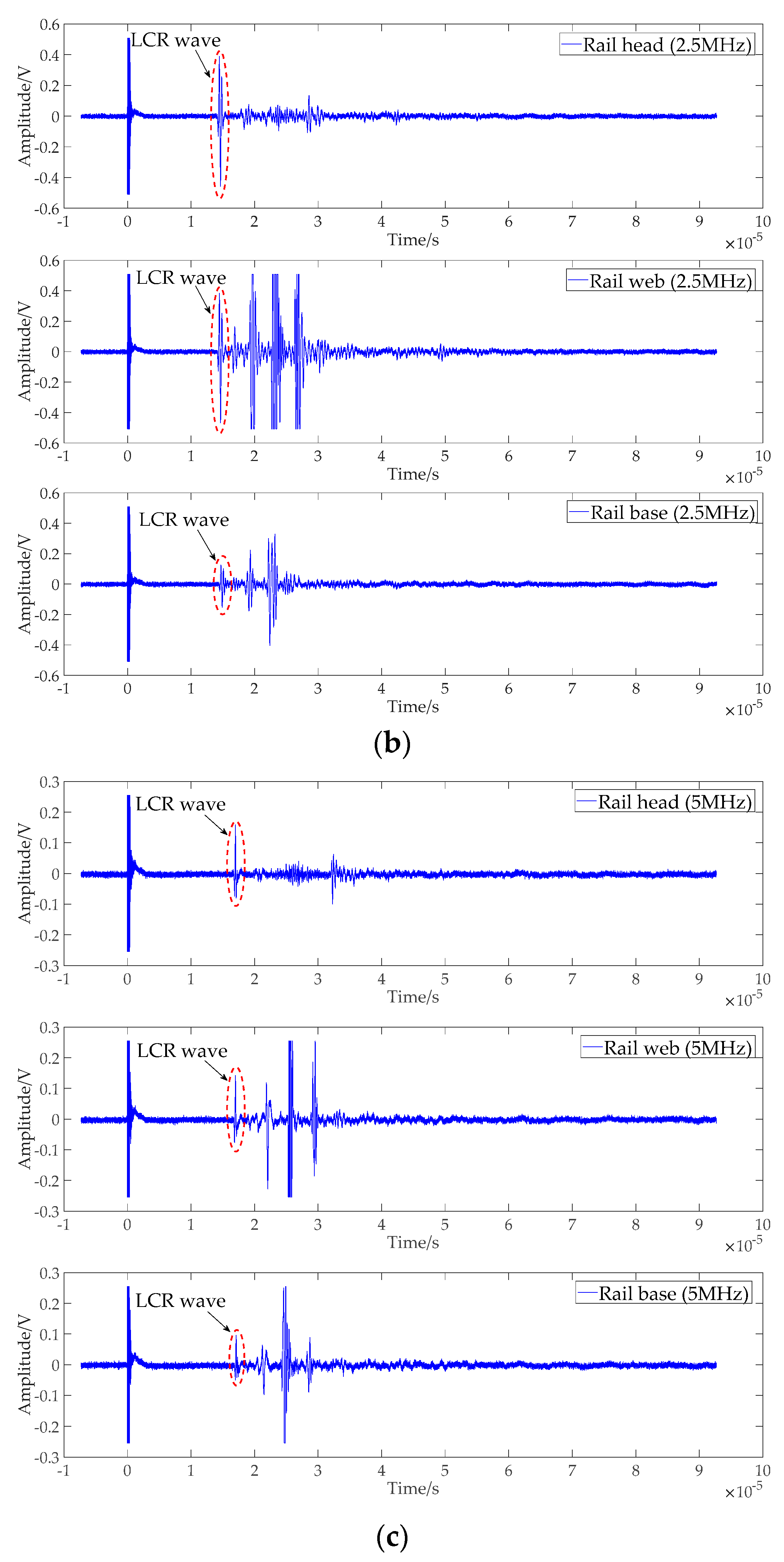

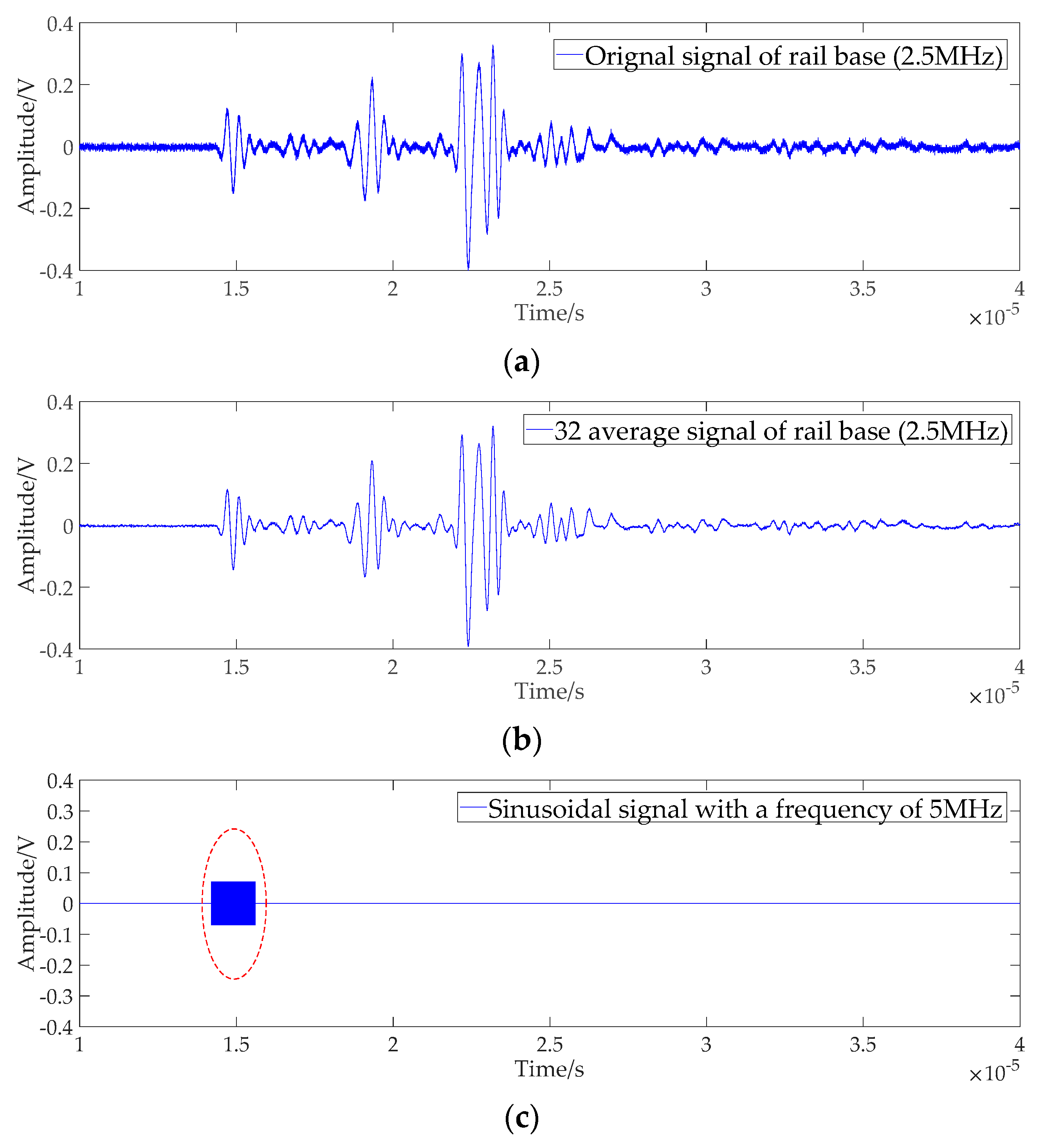
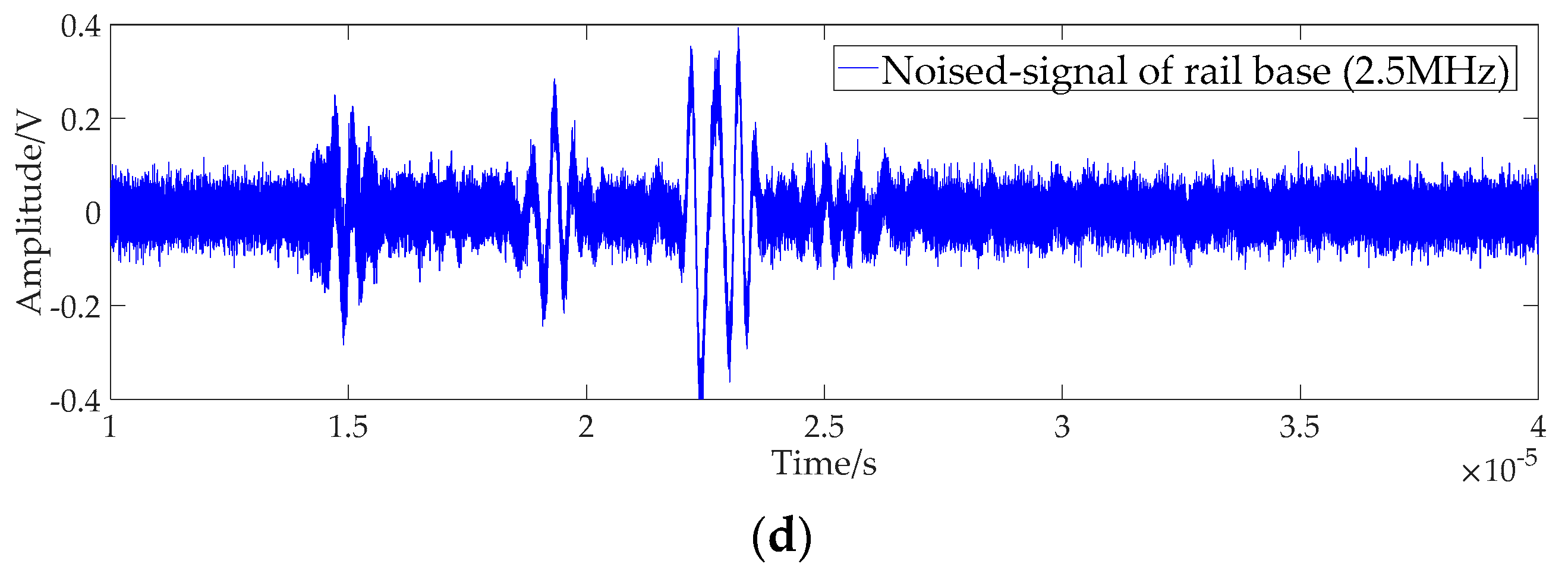


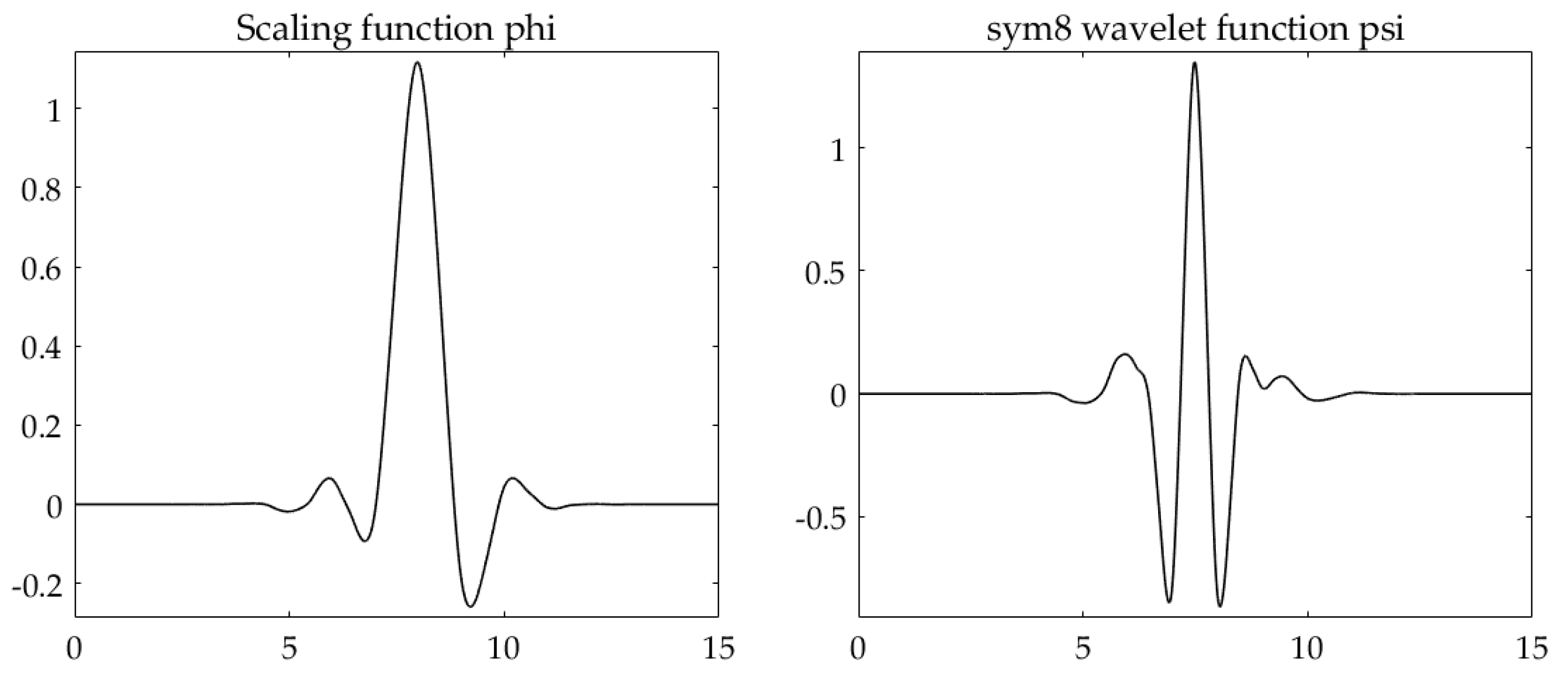

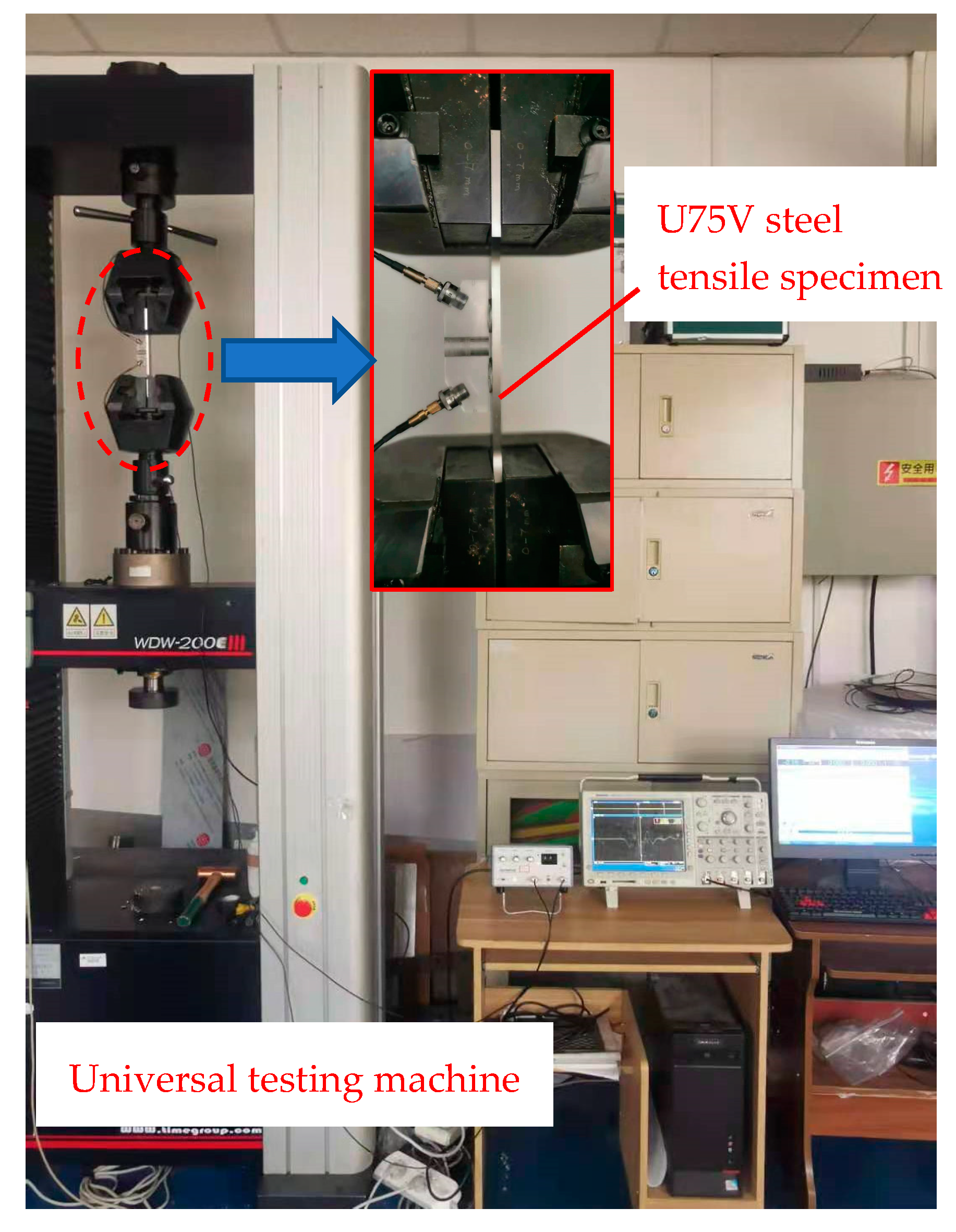


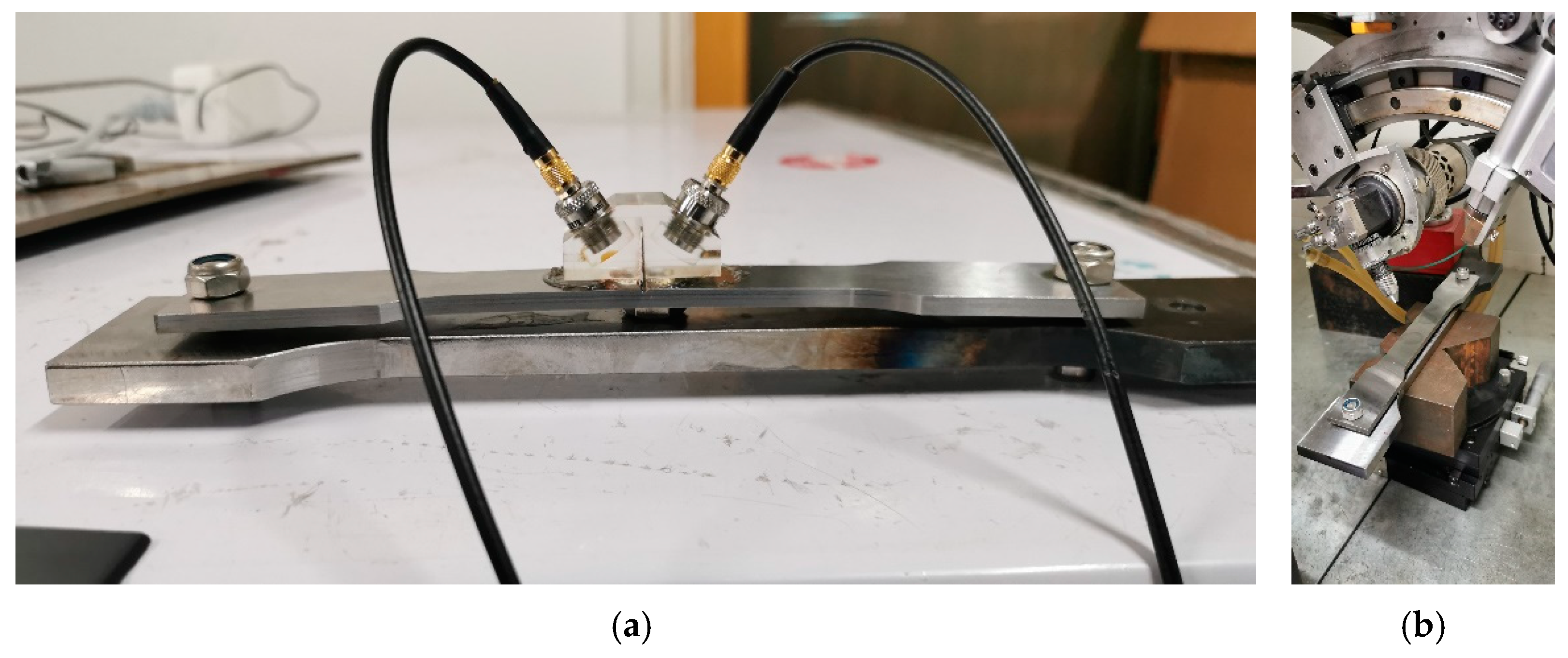

| Noise Signal | WT | WPT | LSWT | LSWPT | |||||
|---|---|---|---|---|---|---|---|---|---|
| S | H | S | H | S | H | S | H | ||
| RMSE | 0.0497 | 0.0039 | 0.0118 | 0.0038 | 0.0038 | 0.0042 | 0.0112 | 0.0035 | 0.0048 |
| SNR (dB) | −2.1253 | 20.0907 | 10.3482 | 20.2092 | 20.2092 | 19.3699 | 10.8017 | 20.1783 | 18.1509 |
| PRE(%) | 124.23 | 7.79 | 105.65 | 4.17 | 4.17 | 0.0556 | 137.74 | 4.25 | 9.33 |
| T (ms) | - | 139.158 | 136.494 | 280.520 | 281.082 | 72.372 | 76.977 | 167.685 | 180.542 |
Publisher’s Note: MDPI stays neutral with regard to jurisdictional claims in published maps and institutional affiliations. |
© 2021 by the authors. Licensee MDPI, Basel, Switzerland. This article is an open access article distributed under the terms and conditions of the Creative Commons Attribution (CC BY) license (https://creativecommons.org/licenses/by/4.0/).
Share and Cite
Li, P.; Xu, C.; Pan, Q.; Lu, Y.; Li, S. Denoising of LCR Wave Signal of Residual Stress for Rail Surface Based on Lifting Scheme Wavelet Packet Transform. Coatings 2021, 11, 496. https://doi.org/10.3390/coatings11050496
Li P, Xu C, Pan Q, Lu Y, Li S. Denoising of LCR Wave Signal of Residual Stress for Rail Surface Based on Lifting Scheme Wavelet Packet Transform. Coatings. 2021; 11(5):496. https://doi.org/10.3390/coatings11050496
Chicago/Turabian StyleLi, Peilu, Chunguang Xu, Qinxue Pan, Yuren Lu, and Shuangyi Li. 2021. "Denoising of LCR Wave Signal of Residual Stress for Rail Surface Based on Lifting Scheme Wavelet Packet Transform" Coatings 11, no. 5: 496. https://doi.org/10.3390/coatings11050496






